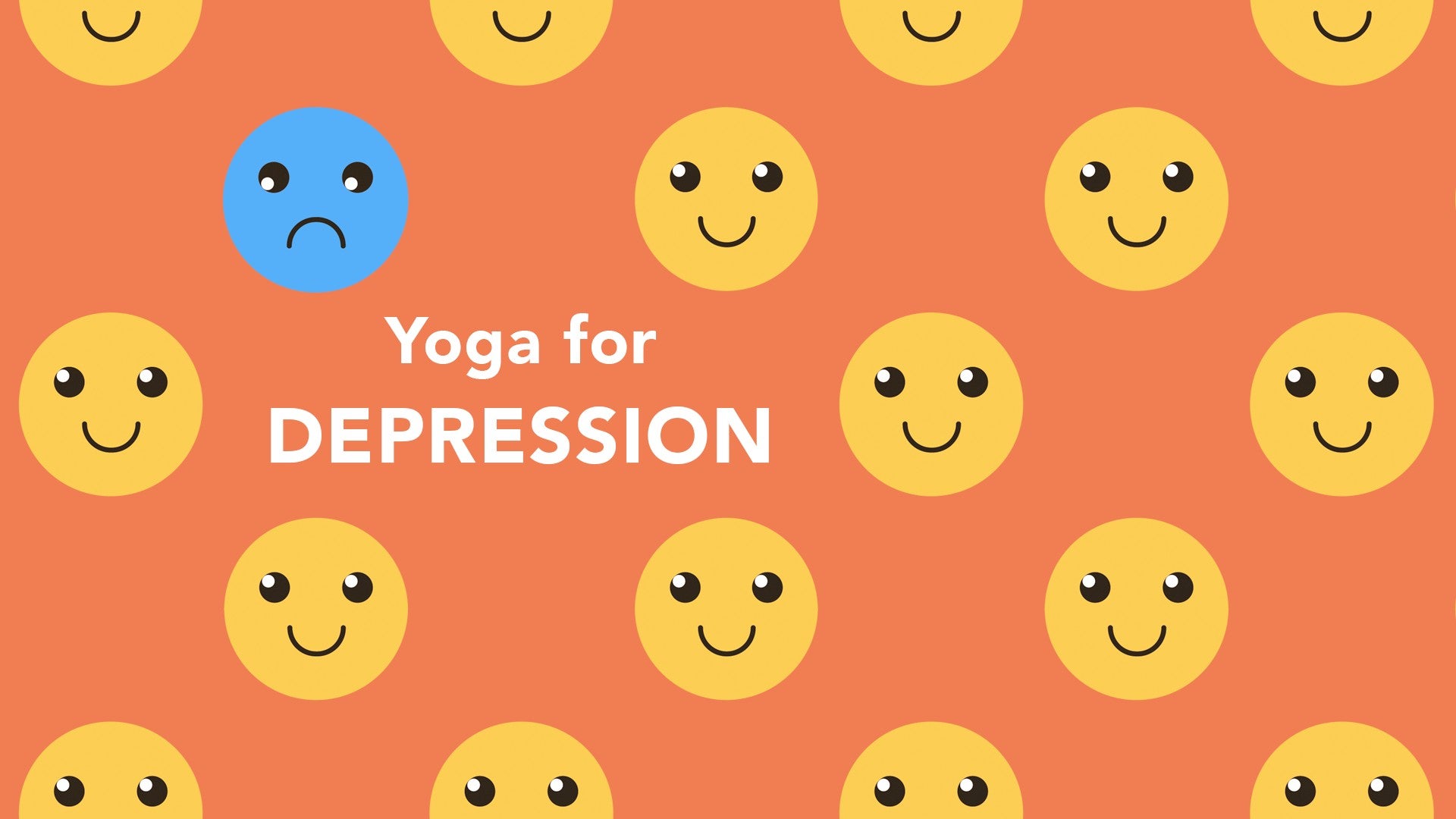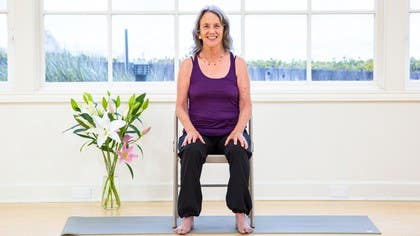Description
About This Video
Transcript
Read Full Transcript
Namaste and welcome back. Taking a look at anxiety and depression today from still looking at it from an ancient tradition and seeing if we can apply those principles to asana pranayama and meditation that you can practice whether you are depressed or whether you're anxious. So the very first concept I want to just really briefly explain is what potentially calls abhyasa and vairagya. Abhyasa means persistent practice to bring the mind back to the present moment, to bring us back into presence. Vairagya means loosening the grip, letting it be.
I'm a little bit reluctant to say letting go because sometimes when we say let go, what happens is we want to let go of all the bad stuff, all the negative emotions that are inhabiting our being. What we really want is to bring to the table everything that we are. All of the joys, all the sorrows, all the traumas, all the history, all of the memories, whether they're ours or our ancestors. And so letting go for me gives me permission to just not like think about stuff. So letting be is a sense of exhaling into the present moment.
So vairagya, loosen the grip and just let things be. So let's start with asana. And I think that there are two pretty distinct ways of coming to the mat when you're depressed and when you're anxious. So let's start with depression, excuse me, the sense of that sunken chest depression. If you think about that, think about what the antidote to that would be.
It would be a sense of spaciousness, wouldn't it? It would be the sense of moving the breath up to where it can soothe and expand. So one way to approach your asana practice is keep your eyes open. Engage with your surroundings. So closing my eyes oftentimes will just bring me right back into the muck.
So engage, keep those eyes open. Focus once again, focus on spaciousness, even if it's in your imagination. Patricia Walden is really fond of saying that physiology begets emotions which beget physiology. So that sense of faking it till you make it is a sense of creating an understanding of spacious possibilities. It's really hard when someone is depressed to encourage her to just get on her feet and get moving and grooving, doing energetic standing poses.
So don't start there. Start quiet. I always start with an inquiry, how am I doing and what do I need to feel better? So that quiet contemplation shouldn't take too long. You don't want to, again, you don't want to get back into wallow mode, but you really want to move from quiet, from a quiet sense.
You might want to start on your back, you might want to start seated. The third way to start, I think, or the third element in beginning your asana practice is to dedicate it to someone you love. It's so much easier sometimes when I'm feeling depressed to think of someone else, someone who brings me a great deal of joy. So even if I don't think I'm worth standing on my mat, someone else might be. So think about that as you commit to your practice.
As far as active poses, I find active poses sequences are a really wonderful way to play. And when I'm depressed, I don't really afford myself a lot of opportunities to play. I don't feel like playing. So in standing poses, I like to move. I like that balance between what Ayangar calls the physical foundation, what's touching the floor, what's holding me up, what can I count on to support me.
And once I feel that sense of support, even if my stance is narrow, that's fine, just to feel a sense of stability, consciousness instability, tamas, from there I can move into what he calls my spiritual foundation, which happens right behind the heart. So if you're in active poses, if you're in standing poses, what would it feel like to float those arms up? What would it feel like to dance in and out of a warrior pose, moving from, or moving from side angle to reverse triangle, just to kind of playing. And checking in with your body, what does my shoulder need? How can I bring the breath up and feel brightness?
So that's the invitation that I see with active poses. I also think that active poses give us an opportunity to build confidence. They give us a true experience of standing on our own two feet. So playing with that concept, I think, is a really wonderful way, it's a wonderful thing to incorporate into your practice. You may find, for example, if you are in warrior pose and this is your experience right now, this is how you feel, what would it feel like to just simply grow your arms a little longer from the back of your heart?
Does that change your experience? Play with it and test out your reaction and see how it feels. And lastly, breathe your asana. So it's that sense of inhaling the arms up, exhaling them over, exhaling the torso forward. So it's not inhale to lift, exhale, it's a matter of breathing the movements and incorporating sound which scientists have said can really increase tone in the vagus nerve.
So sigh, hum, moan, ohm, whatever it is to get that sense of sound deep into the pelvic floor. And finally, no scrunching. So if you feel like you're in a pose and you're here, you may feel like this is a contraction. You're already contracted in your mind. So what would it feel like to pull back on the pose until you feel that spaciousness?
So seriously, no scrunching allowed. And what about anxiety? How is it that we practice asana when we're anxious? It's pretty much opposite to what the depression practice is. If I'm anxious and I start in a restorative pose, what's my mind likely to do?
Probably keep spinning, keep that story moving, keep the rumination happening, the obsessions happening. So what would help that is to get that anxiety, that stress, and move those sensations into the body. Again, I keep quoting Ayyengar, I know, but Mr. Ayyengar says that you cannot meditate stress away from the mind. You have to move the sensations into the body. So start in your feet, start finding those feet.
If you're a little reluctant to get up right away and go into a downer-facing dog or going to tadasana, then start seated with your legs straight out in dandasana and simply tap your toes together. Feel the connection to your feet, massage your legs, move the energy into the body. Start that way, then get up on your feet. Feel what it feels like to be grounded. That's not so much my experience when I'm anxious.
Standing poses ground us, where are your feet? Where's your strength? What's holding you up? Sun salutes, awesome thing to do. When I'm anxious, I tend to want to do, once again, I want to breathe those sun salutes alive.
So I often will do very modified, maybe half sun salutes with my eyes closed. I want to feel the movement of my spine. I want to be in my body. The more that my eyes are open, they tend to go outwardly focused and to glom onto something else to really attach to something that's other than myself. So you might try very simple half sun salutes, feeling every articulation of the vertebrae, every movement as you come forward and play and see if that moves the energy a little bit more into your body.
And once you feel like the energy is diffused, time for relaxation. But again, what really helps when you're anxious is to begin relaxation poses with movement. So you might be in constructive rest pose, you might be in a bridge pose and see if you can create some movement, arms up, overhead and back down, articulation of the spine by arching and rounding, nice little side spinal twists, just kind of moving in and out until you're ready for shavasana. And I would also encourage you to do a guided shavasana instead of allowing your mind, even though your mind will probably be more settled and you probably will feel the sensations in your body, still to have that much alone time with your own mind can sometimes be problematic. So a guided shavasana is a wonderful way to end your practice.
Pranayama, pranayama always follows asana. We understand and we get into the body first. We connect with and communicate with what we know and can feel best. And so now pranayama precedes meditation because now we want to introduce the breath in a way that we can extend and control it. So we want to know that that's possible.
When I'm anxious, pranayama can be a challenge. Maybe pranayama with retention. So you inhale, you hang out there for a few counts, you exhale, you pause. That gives the mind way too many opportunities to fill that space. So instead play with the circular breath, inhale, exhale, allow the exhale to begin and the inhale which then allows the exhale to come and just gently circular.
And I will say whether you are depressed or anxious, do not be aggressive in your inhales because aggression in your inhale will make you anxious. For depression, pranayama, you can retain a little bit in pranayama if you're depressed. But what I would encourage are two things. What you're looking for as you play with the breath is brightness, right, spaciousness. And so one way to get that automatically or right away is to create a posture that encourages it.
So you might lie down and put a rolled blanket under your, just beneath your shoulder blades. That keeps, it keeps the chest open and the shoulders relaxed and it encourages the breath to have a little bit more real estate. So that's a really sweet thing to try. Again, whether or not you're depressed or anxious, ujjayi breathing, ujjayi pranayama is particularly indicated because it has sound. And once again, we go back to that whole vagal tone.
Real tone responds really well to sound in the breath, whether it's humming, chanting, ujjayi. So ujjayi is really, really important whether or not you're depressed or anxious. Nadi shodana. Again, if you're anxious and this is a new practice for you, don't worry about what you do with your hand. Just simply visualize the inhale going up one side and keep it on one side if you'd like.
Just inhale and exhale up the left three or four times, inhale, exhale up the right. And then if it feels good and you want to move on, inhale up the left, exhale right, inhale right, exhale left. Anytime it gets agitating, return to your normal breathing. And please stop counting your breaths. Counting your breaths, engage the mind in a way that I don't necessarily think is, I mean I just don't think it's necessary.
It's nice to be able to do pranayama so it's balanced. So you do the same number on the left as the right. But the more you get intent on doing something exactly right, the more agitating it is. And with pranayama, when you're depressed, yes, the emphasis is on the inhale, but not at the expense of the exhale. We want the inhale to enliven and to, I think of it as clearing, creating clarity, but we want the exhale to be complete.
So think about that as you're sort of rising up with the inhale and then softly releasing on that exhale. That is the exact opposite, inhale gently, sweetly, and then exhale completely. Once again, when you're really anxious, it's really hard, I mean it's hard for me to exhale. So I tend to want to flutter my lips. So I inhale and then I just simply, not really attractive, but really effective.
And now meditation. Once again, meditation is really, really hard when you're depressed or anxious. When I'm depressed, it's hard for me to sit and not beat myself up for not doing it correctly. So I'll sit down and I think, oh, why did I think I knew how to do this? All of a sudden my posture goes from open to right back to that sense of sunkenness.
And the minute that that happens, where's my breath? There's no way that I have freedom in my breathing. And so the meditation actually isn't very helpful. When I'm anxious, I mean once again, my mind has moved me from present moment to perhaps something that happened when I was seven. And I'm often running into a world that no longer exists.
So what to do? My sense is mantra, whether you're depressed or anxious, anchor your meditation with mantra. Again, when I count my breaths, if I'm depressed, I always get more depressed when I only get to two and I have to start over again. So I would rather find a phrase, a sound that means something to me that can remind me of my basic goodness. That can be so hum.
It could be a Sanskrit mantra. You know what? It could also be I am enough. It could merely be yes, I am. So whatever will allow you to inhale a word and exhale the next word, syllable, really, really important.
Chanting, for those who really respond to chanting, awesome idea, awesome idea, brings you really into your experience and keeps you there. If it's really difficult to sit and to feel like meditation is at all helpful, guided visualizations are a wonderful way to keep you in your body, to keep you grounded. Anytime has all kinds of visualizations that will help. Also imagery, imagery is a wonderful way to stay focused. So wonderful yoga teacher, Nisha Ladevi, who teaches in a lot of hospitals.
One of the things that she taught me was to inhale, so in the inhale process in meditation, as you inhale, inhale what it is that you need that could be ease, it could be joy, it could be relief, whatever that, it could be love. And exhale, as you exhale, visualize your gift going out to the world. So you inhale, ease possibly, and you exhale gratitude or whatever your words are, whatever your gift is, it's a beautiful way to do two things, to keep you anchored in the body for sure and to expand beyond the self and to understand that interconnection that guides us to wholeness when we know that we're not alone and we know that there's something much greater than what it is that we're dealing with at this very moment, in this very breath. So I hope that these practices were helpful and the suggestions as you go about creating your own practice, once again, whether you go into a classroom, whether you have your personal practice or whether indeed you are of service to others. Thank you so much and I look forward to hearing your own suggestions and let me know if any of this worked.
Namaste.
Yoga for Depression: Linda Sparrowe
Comments
You need to be a subscriber to post a comment.
Please Log In or Create an Account to start your free trial.










